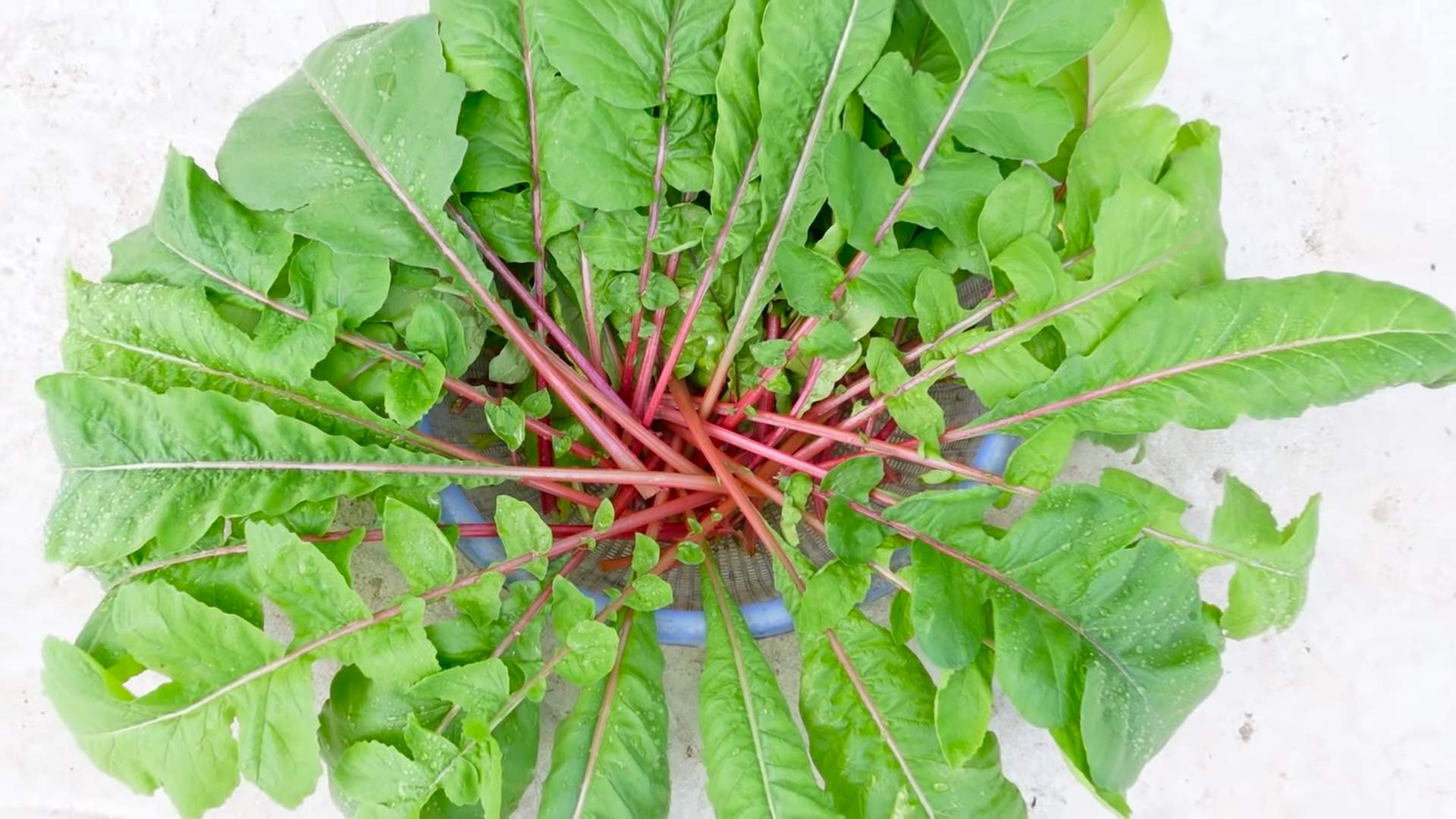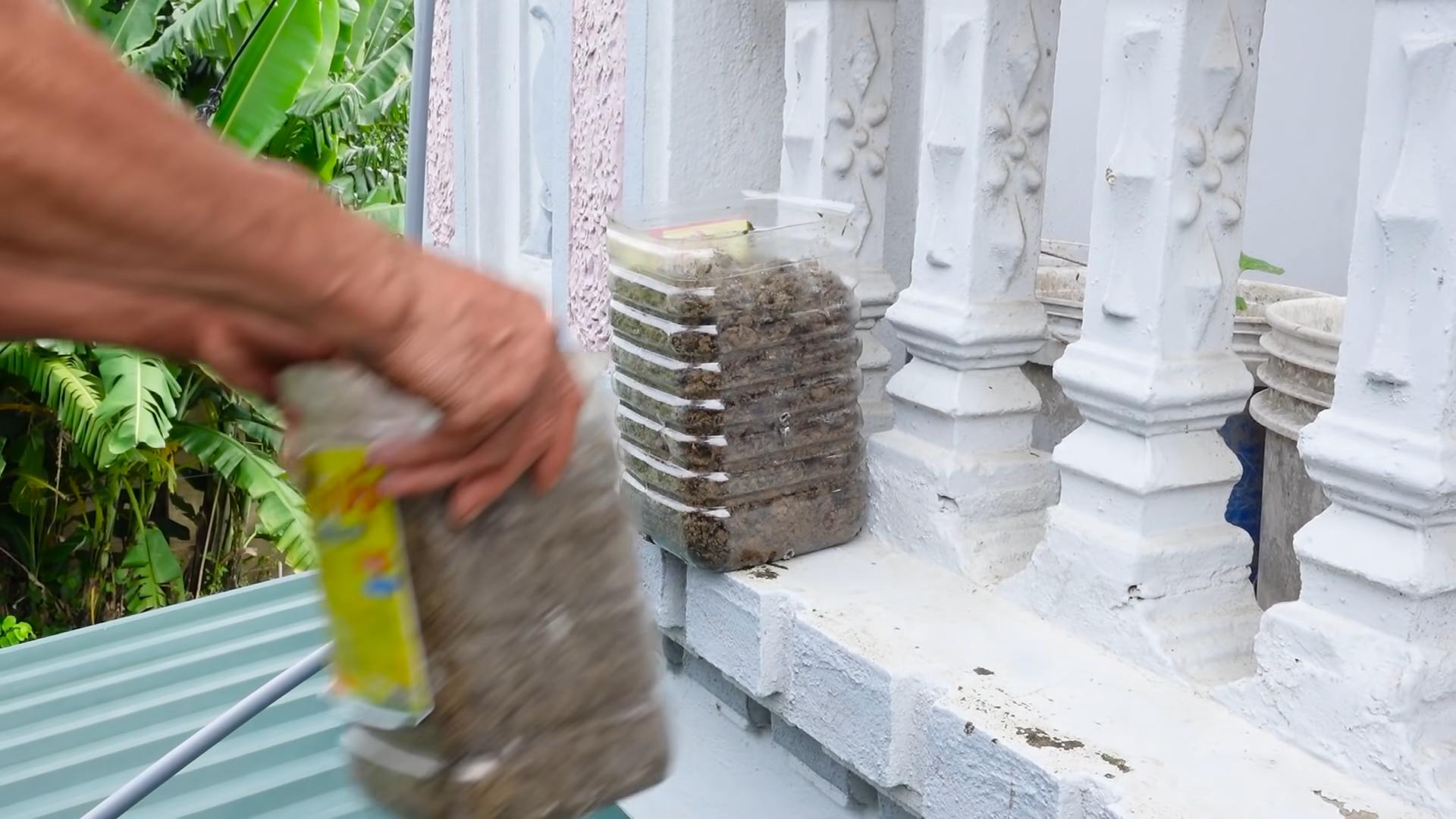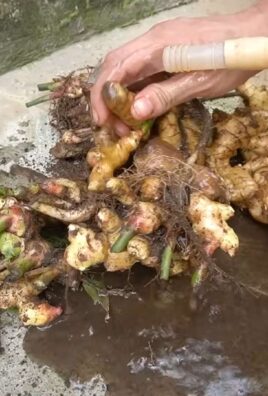DIY Cabbage Bottle Planters: Who knew your empty plastic bottles could transform into adorable, eco-friendly homes for your cabbages? I’m excited to share this super simple and rewarding DIY project that’s perfect for beginner gardeners and seasoned pros alike! Forget those expensive nursery pots – we’re going green and getting creative!
Upcycling has a rich history, born out of necessity and evolving into a conscious choice for sustainability. Think of the “make do and mend” ethos of past generations, where resourcefulness was key. Today, we’re bringing that spirit into our gardens, turning waste into wonder. This isn’t just about saving money; it’s about reducing our environmental footprint and adding a personal touch to our green spaces.
Why do you need this DIY Cabbage Bottle Planter trick? Well, for starters, it’s incredibly budget-friendly. But more importantly, it’s a fantastic way to start seedlings indoors, protect young plants from pests, and even create a mini-greenhouse effect. Plus, let’s be honest, they look pretty darn cute! Imagine rows of vibrant green cabbages sprouting from colorful, repurposed bottles – a testament to your creativity and commitment to a greener lifestyle. So, grab those empty bottles, and let’s get planting!

DIY Cabbage Bottle Planters: Upcycling for a Unique Garden
Hey there, fellow gardening enthusiasts! I’m so excited to share this super fun and eco-friendly DIY project with you: turning old plastic bottles into adorable cabbage-shaped planters. It’s a fantastic way to reuse those bottles that would otherwise end up in the landfill, and it adds a whimsical touch to your garden, balcony, or even your windowsill. Plus, it’s surprisingly easy!
Materials You’ll Need
Before we dive in, let’s gather all the necessary supplies. Don’t worry, most of these are probably already lying around your house!
* Plastic Bottles: You’ll need several plastic bottles of the same size and shape. I recommend using bottles that are relatively smooth and cylindrical, as they’ll be easier to work with. Think about 2-liter soda bottles or large juice bottles. The number of bottles you need will depend on how big you want your cabbage planter to be. For a medium-sized planter, I usually use around 6-8 bottles.
* Craft Knife or Scissors: A sharp craft knife is ideal for cutting the plastic, but sturdy scissors will also work. Just be careful!
* Hot Glue Gun and Glue Sticks: This is essential for assembling the cabbage leaves. Make sure you have enough glue sticks on hand.
* Green Spray Paint: Choose a shade of green that you like for your cabbage. I prefer a slightly muted, natural-looking green. You might also want to have a darker green for adding some shading later.
* Primer (Optional): If you want the paint to adhere really well to the plastic, especially if your bottles are glossy, a plastic primer is a good idea.
* Potting Soil: Obviously, you’ll need soil to plant your flowers or herbs!
* Plants: Choose your favorite flowers, herbs, or succulents to plant in your new cabbage planter.
* Gloves: To protect your hands from the paint and glue.
* Newspaper or Drop Cloth: To protect your work surface from paint.
* Pencil or Marker: For marking cutting lines.
* Ruler or Measuring Tape: For ensuring consistent leaf sizes (optional).
Preparing the Bottle “Leaves”
This is where the magic begins! We’ll be transforming those plain plastic bottles into realistic-looking cabbage leaves.
1. Clean the Bottles: Start by thoroughly cleaning all the plastic bottles with soap and water. Remove any labels and dry them completely. This will help the paint adhere better.
2. Cut the Bottles: Now comes the cutting. This is the most time-consuming part, but it’s also the most important. You’ll be cutting the bottles into leaf shapes. Here’s how I do it:
* Cut off the Top and Bottom: Use your craft knife or scissors to cut off the top and bottom of each bottle. You want to be left with the cylindrical middle section.
* Cut Along the Seam: Cut along the vertical seam of the cylinder to open it up into a flat sheet of plastic.
* Draw Leaf Shapes: On each sheet of plastic, draw leaf shapes using your pencil or marker. The size and shape of the leaves will determine the overall look of your cabbage. I like to vary the sizes and shapes to make it look more natural. Think about real cabbage leaves – they’re not all perfectly uniform! Aim for a mix of larger, outer leaves and smaller, inner leaves. You can use a ruler to make sure the base of each leaf is roughly the same width, which will help with assembly later.
* Cut Out the Leaves: Carefully cut out the leaf shapes you’ve drawn. Try to make the edges slightly wavy or jagged to mimic the texture of real cabbage leaves.
3. Shape the Leaves: This step is optional, but it can really enhance the realism of your cabbage. You can gently bend and curve the plastic leaves to give them a more three-dimensional shape. You can also use a heat gun on a low setting to gently warm the plastic and make it more pliable. Be extremely careful if you use a heat gun, as the plastic can melt easily. I usually just use my hands to bend and shape the leaves.
Painting the Leaves
Time to add some color! This is where your cabbage really starts to come to life.
1. Prime the Leaves (Optional): If you’re using a primer, apply a thin, even coat to all the plastic leaves. Let it dry completely according to the manufacturer’s instructions. This will help the paint adhere better and prevent it from peeling.
2. Spray Paint the Leaves: In a well-ventilated area, lay out your newspaper or drop cloth. Arrange the plastic leaves on the protected surface. Apply a thin, even coat of green spray paint to all the leaves. Make sure to get both sides of the leaves. Let the paint dry completely.
3. Add Shading (Optional): To add some depth and dimension to your cabbage, you can use a darker shade of green spray paint to add some shading. Lightly spray the edges and veins of the leaves with the darker green. You can also use a dry brush technique to apply the darker green paint. This involves dipping a dry brush into the paint, wiping off most of the paint, and then lightly brushing the leaves. This will create a subtle, textured effect.
Assembling the Cabbage Planter
Now for the fun part – putting it all together!
1. Create the Base: Choose one of your larger plastic leaves to be the base of your cabbage planter. This will be the foundation upon which you build the rest of the cabbage.
2. Start Gluing: Using your hot glue gun, apply a small amount of hot glue to the base of another leaf. Attach this leaf to the base leaf, overlapping it slightly. Hold the leaf in place until the glue cools and sets.
3. Continue Gluing: Continue adding leaves around the base, overlapping them and varying their sizes and shapes. Work your way outwards and upwards, gradually building up the cabbage shape. I like to start with the larger leaves on the outside and then use the smaller leaves to fill in the gaps and create a more rounded shape.
4. Create the Center: As you get closer to the center of the cabbage, use smaller and smaller leaves. Curl the leaves inwards to create a tight, compact center.
5. Reinforce the Structure: Once you’ve finished assembling the cabbage, go back and reinforce any areas that seem weak or unstable. Add extra glue to the seams and joints to make sure everything is securely attached.
Adding Drainage and Planting
Almost there! Now we just need to add drainage and plant our flowers or herbs.
1. Add Drainage Holes: Before you add soil, you’ll need to create some drainage holes in the bottom of the cabbage planter. You can use a drill to create several small holes, or you can simply poke holes in the plastic with a sharp object. Make sure the holes are large enough to allow water to drain freely.
2. Add Soil: Fill the cabbage planter with potting soil. Leave a little bit of space at the top for watering.
3. Plant Your Flowers or Herbs: Carefully plant your chosen flowers, herbs, or succulents in the soil. Arrange them in a way that is pleasing to you.
4. Water Thoroughly: Water the plants thoroughly after planting.
Finishing Touches
And that’s it! Your DIY cabbage bottle planter is complete! Here are a few extra tips to make it even better:
* Add a Protective Coating: To protect your cabbage planter from the elements, you can apply a clear coat of sealant. This will help prevent the paint from fading or peeling.
* Experiment with Colors: Don’t be afraid to experiment with different colors of spray paint. You could create a red cabbage planter, or even a variegated cabbage planter with different shades of green and purple.
* Add Embellishments: You can add other embellishments to your cabbage planter, such as artificial dew drops, ladybugs, or butterflies.
* Consider the Location: Think about where you’ll be placing your cabbage planter. If it’s going to be in direct sunlight, choose plants that can tolerate full sun. If it’s going to be in a shady area, choose plants that prefer shade.
I hope you enjoyed this DIY project! It’s a fun, creative, and eco-friendly way to add a unique touch to your garden. Happy planting!

Conclusion
So, there you have it! Transforming humble cabbage and discarded plastic bottles into charming, eco-friendly planters is not just a fun craft project; it’s a small act of rebellion against waste and a celebration of resourcefulness. We’ve shown you how to create these unique planters, and we truly believe this DIY cabbage bottle planter trick is a must-try for several compelling reasons.
Firstly, it’s incredibly budget-friendly. You’re likely already buying cabbage for your meals, and plastic bottles are, unfortunately, all too common. This project repurposes these readily available materials, saving you money on expensive store-bought planters. Think of all the beautiful flowers or herbs you can now afford to plant!
Secondly, it’s environmentally conscious. By giving plastic bottles a new lease on life, you’re reducing plastic waste and contributing to a more sustainable lifestyle. Every little bit helps, and this is a tangible way to make a difference. Plus, the natural decomposition of the cabbage adds nutrients back into the soil, creating a mini-ecosystem for your plants.
Thirdly, it’s aesthetically pleasing. The rustic charm of the cabbage combined with the upcycled bottle creates a unique and eye-catching planter that will add character to your garden, balcony, or even your windowsill. It’s a conversation starter and a testament to your creativity.
But the benefits don’t stop there! This project is also incredibly versatile. Feel free to experiment with different varieties of cabbage. Red cabbage will add a vibrant splash of color, while savoy cabbage offers a more textured and rustic look. You can also use different sizes and shapes of plastic bottles to create planters of varying heights and widths.
Consider painting the plastic bottles to match your garden décor or adding decorative elements like twine, beads, or even mosaic tiles. Get creative and personalize your planters to reflect your unique style. You could even try using other leafy vegetables like lettuce or kale, although cabbage tends to hold its shape the best.
For a more advanced variation, try incorporating a self-watering system. Simply add a wick made of cotton rope or felt that extends from the bottom of the bottle into a reservoir of water. This will help keep your plants consistently hydrated, especially during hot weather.
Another fun idea is to create a vertical garden using multiple cabbage bottle planters. Simply attach them to a wall or fence using hooks or wire. This is a great way to maximize space and add a touch of greenery to even the smallest of areas.
We are confident that you’ll find this DIY project rewarding and enjoyable. It’s a simple yet effective way to reduce waste, save money, and add a touch of beauty to your surroundings.
So, what are you waiting for? Gather your supplies, unleash your creativity, and give this DIY cabbage bottle planter trick a try! We’re eager to see your creations. Don’t forget to share your photos and experiences with us in the comments below or on social media using #CabbageBottlePlanters. We can’t wait to see what you come up with! Let’s transform trash into treasure, one cabbage bottle planter at a time.
Frequently Asked Questions
What kind of cabbage works best for this project?
While any type of cabbage can technically be used, we recommend using a firm, tightly packed head of cabbage like green cabbage or red cabbage. These varieties tend to hold their shape better and last longer. Savoy cabbage can also be used, but it may decompose slightly faster due to its looser leaves. Avoid using overly ripe or damaged cabbage, as it will not provide a stable base for your planter. The size of the cabbage will also dictate the size of the bottle you can use. A larger cabbage head will naturally accommodate a larger bottle.
What kind of plastic bottles are suitable?
Almost any plastic bottle can be used, but we recommend using bottles that are relatively sturdy and have a smooth surface. Soda bottles, water bottles, and juice bottles are all good options. Avoid using bottles that are too thin or flimsy, as they may collapse under the weight of the soil and plants. The size of the bottle will depend on the size of the cabbage head you are using. Make sure the bottle is clean and free of any residue before using it. You can also experiment with different colors of bottles to create a more visually appealing planter.
How long will the cabbage last before it starts to decompose?
The lifespan of the cabbage planter will depend on several factors, including the type of cabbage, the climate, and the watering frequency. In general, you can expect the cabbage to last for several weeks to a few months. As the cabbage decomposes, it will release nutrients into the soil, which can benefit your plants. However, you will eventually need to replace the cabbage when it becomes too soft or starts to smell. To prolong the life of the cabbage, avoid overwatering and ensure that the planter is well-drained. You can also try applying a thin layer of sealant to the inside of the cabbage to slow down the decomposition process.
What kind of plants can I grow in a cabbage bottle planter?
You can grow a wide variety of plants in a cabbage bottle planter, depending on the size of the planter and the amount of sunlight it receives. Herbs like basil, mint, and thyme are excellent choices, as they are relatively small and easy to grow. You can also grow flowers like pansies, petunias, and marigolds. For larger planters, you can try growing vegetables like lettuce, spinach, or even small tomato plants. Be sure to choose plants that are appropriate for the size of the planter and the growing conditions in your area. Consider the drainage needs of the plants you select, as the cabbage itself will retain some moisture.
How do I water my plants in a cabbage bottle planter?
Watering your plants in a cabbage bottle planter is similar to watering plants in any other type of planter. The key is to water thoroughly but avoid overwatering. Water the soil until it is evenly moist, but be careful not to let the water pool at the bottom of the bottle. Overwatering can lead to root rot and other problems. The cabbage itself will retain some moisture, so you may not need to water as frequently as you would with a traditional planter. Check the soil moisture regularly and water when the top inch or two of soil feels dry to the touch. Consider using a watering can with a long spout to reach the soil without getting the cabbage too wet.
Can I reuse the plastic bottle and cabbage for another planting?
Yes, you can reuse the plastic bottle for multiple plantings. Simply clean it thoroughly with soap and water after removing the old cabbage and soil. However, the cabbage itself cannot be reused, as it will decompose over time. You will need to replace the cabbage with a fresh head for each planting. Consider composting the old cabbage to reduce waste and enrich your garden soil.
Is this project suitable for children?
Yes, this project is generally suitable for children, but adult supervision is recommended, especially when using sharp objects like knives or scissors. Children can help with tasks like cleaning the plastic bottle, filling the planter with soil, and planting the seeds or seedlings. This is a great way to teach children about recycling, gardening, and the importance of sustainability. Make sure to explain the safety precautions clearly and supervise them closely throughout the project.
How do I ensure proper drainage in my cabbage bottle planter?
Proper drainage is crucial for the health of your plants. To ensure proper drainage in your cabbage bottle planter, make sure to create drainage holes in the bottom of the plastic bottle. You can use a drill, a knife, or even a hot nail to create these holes. Add a layer of gravel or pebbles to the bottom of the bottle before adding the soil. This will help to prevent the drainage holes from becoming clogged. Avoid overwatering, as this can lead to waterlogging and root rot. If you notice that the soil is consistently wet, you may need to add more drainage holes or use a lighter, more well-draining soil mix.




Leave a Comment